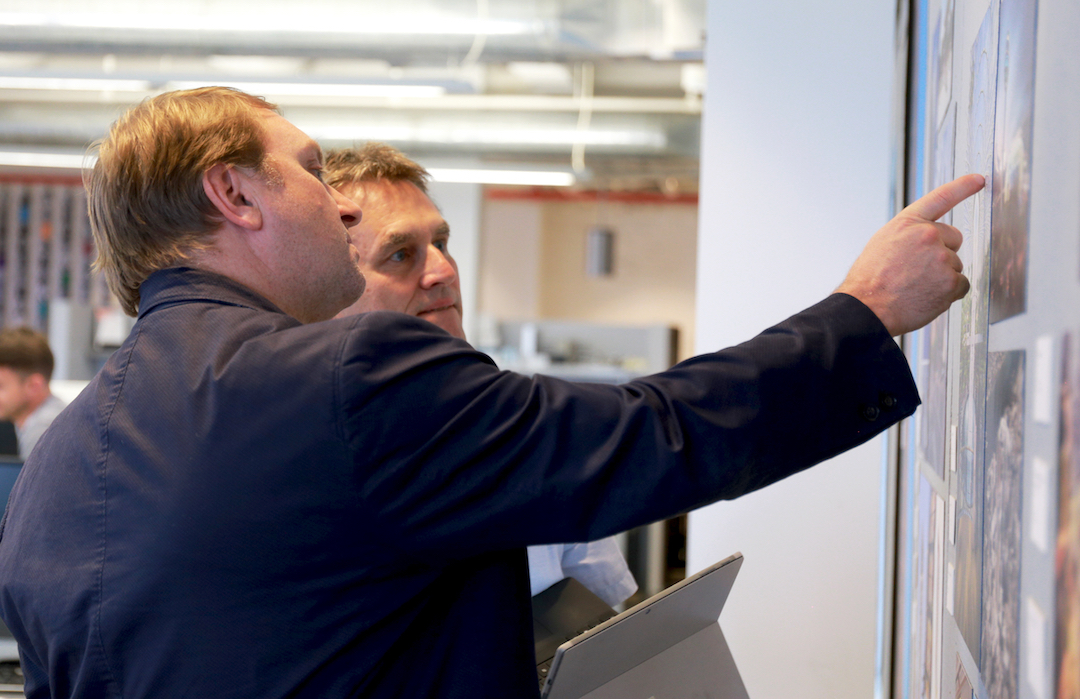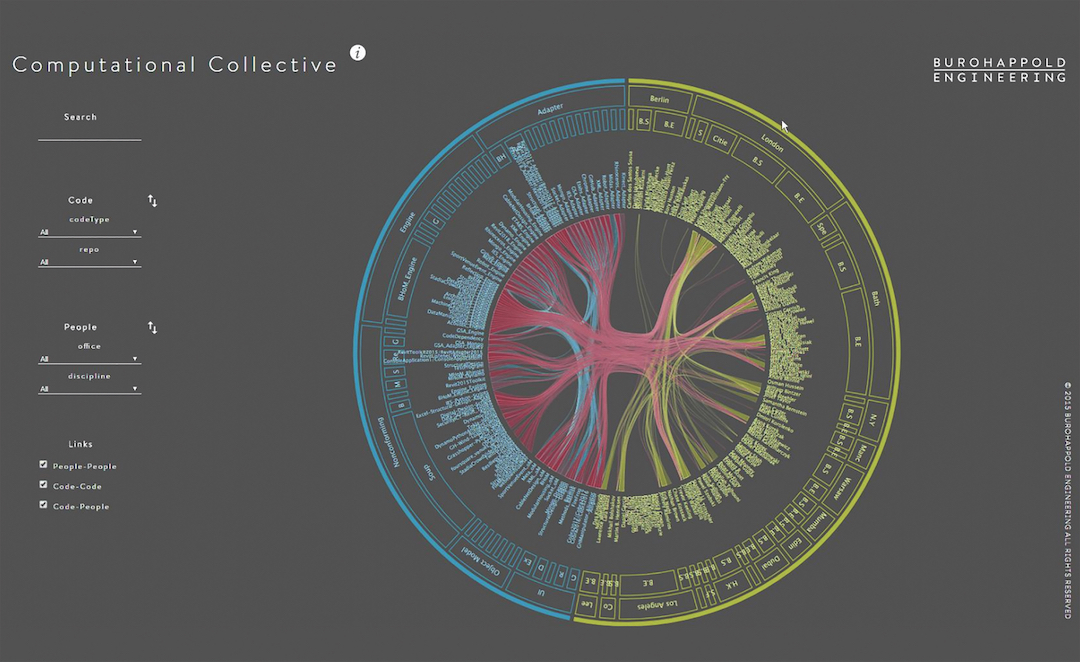Four years ago, at one of its technology gatherings, the engineering firm BuroHappold concluded that “we weren’t connected enough as a company,” recalls Craig Schwitter, PE, a Partner who has been with the firm since 1992 and leads its multidisciplinary projects.
To take advantage of available communications tools, Buro Happold formed its Computational Collective, which Schwitter says presents the firm’s employees with “a different way of thinking and working.”
Buro Happold's feedback loop
The Collective now has 400 members across all of the firm’s practices and offices. “It’s a way of democratizing technology, and all you have to do to be in the Collective is to contribute to it,” says Schwitter.
Where the Collective is about encouraging employees to interact, BuroHappold has also recently established a data exchange framework BHoM (for Buildings & Habitats object Model), which Schwitter says emerged from the Collective and allows for practical interfaces among teams. Last year, the firm unveiled its open-source website, BHoM.xyz.
BuroHappold has been moving in this collaborative direction for a while. One of its recent signature projects—the 1.4 million-sf retail and lifestyle complex at Jewel Changi Airport in Singapore, with its 131-foot-tall indoor rain vortex that pours from an oculus within a glass-domed roof—required the engagement of several of the firm’s offices, including New York, Boston, London, and Hong Kong. Schwitter agrees that this project could be viewed as a precursor to the Collective.
SEE ALSO: Clayco seeks the cutting edge as a competitive advantage
The ultimate goal of these changes, he says, is a process for tracking, measuring, and predicting human behavior for the purpose of designing and engineering better buildings. “How do you measure happiness, wellness? We see a future where we can measure the human experience. That’s like a light bulb going off for an engineer, and it’s a very motivating concept for me. But without data, we wouldn’t be able to even ask these questions.”
Innovations include digital twins for hospitals
Schwitter says BuroHappold is “very close” to being able to create digital twins for hospitals and other building types that incorporate human behavioral data. And one of Schwitter’s colleagues, Wolf Mangelsdorf, a Group Director and Partner with the firm, has formulated a “science of place” design strategy to multifamily housing, in what he calls “Wechselwirkungen.”
The intent is to reconcile design models and “interventions” that stem from community input with occupant and community needs, to create a continuous feedback loop that would define the criteria for deciding which design will works best.
 Craig Schwitter, PE (at left), a Partner, says the Computational Collective has changed the way people within the firm communicate and work together. Photo: Buro Happold
Craig Schwitter, PE (at left), a Partner, says the Computational Collective has changed the way people within the firm communicate and work together. Photo: Buro Happold

Related Stories
AEC Innovators | Apr 15, 2024
3 ways the most innovative companies work differently
Gensler’s pre-pandemic workplace research reinforced that great workplace design drives creativity and innovation. Using six performance indicators, we're able to view workers’ perceptions of the quality of innovation, creativity, and leadership in an employee’s organization.
Sustainability | Mar 21, 2024
World’s first TRUE-certified building project completed in California
GENESIS Marina, an expansive laboratory and office campus in Brisbane, Calif., is the world’s first Total Resource Use and Efficiency (TRUE)-certified construction endeavor. The certification recognizes projects that achieve outstanding levels of resource efficiency through waste reduction, reuse, and recycling practices.
AEC Innovators | Feb 28, 2024
How Suffolk Construction identifies ConTech and PropTech startups for investment, adoption
Contractor giant Suffolk Construction has invested in 27 ConTech and PropTech companies since 2019 through its Suffolk Technologies venture capital firm. Parker Mundt, Suffolk Technologies’ Vice President–Platforms, recently spoke with Building Design+Construction about his company’s investment strategy.
MFPRO+ Special Reports | Feb 22, 2024
Crystal Lagoons: A deep dive into real estate's most extreme guest amenity
These year-round, manmade, crystal clear blue lagoons offer a groundbreaking technology with immense potential to redefine the concept of water amenities. However, navigating regulatory challenges and ensuring long-term sustainability are crucial to success with Crystal Lagoons.
AEC Tech | Feb 20, 2024
AI for construction: What kind of tool can artificial intelligence become for AEC teams?
Avoiding the hype and gathering good data are half the battle toward making artificial intelligence tools useful for performing design, operational, and jobsite tasks.
Sustainability | Nov 1, 2023
Researchers create building air leakage detection system using a camera in real time
Researchers at the U.S. Department of Energy’s Oak Ridge National Laboratory have developed a system that uses a camera to detect air leakage from buildings in real time.
Contractors | Aug 14, 2023
Fast-tracking construction projects offers both risk and reward
Understanding both the rewards and risk of fast-tracking a project can help owners, architects, engineers, and contractors maximize the benefits of this strategy and can bring great reward on all fronts when managed properly.
Resiliency | Aug 7, 2023
Creative ways cities are seeking to beat urban heat gain
As temperatures in many areas hit record highs this summer, cities around the world are turning to creative solutions to cope with the heat. Here are several creative ways cities are seeking to beat urban heat gain.
Digital Twin | Jul 31, 2023
Creating the foundation for a Digital Twin
Aligning the BIM model with the owner’s asset management system is the crucial first step in creating a Digital Twin. By following these guidelines, organizations can harness the power of Digital Twins to optimize facility management, maintenance planning, and decision-making throughout the building’s lifecycle.
AEC Innovators | Jun 15, 2023
Rogers-O'Brien Construction pilots wearables to reduce heat-related injuries on jobsites
Rogers-O'Brien Construction (RO) has launched a pilot program utilizing SafeGuard, a safety-as-a-service platform for real-time health and safety risk assessment. Non-invasive wearables connected to SafeGuard continuously monitor personnel to prevent heat exhaustion on jobsites, reducing the risk of related injuries. RO is the first general contractor to pilot this program.

















